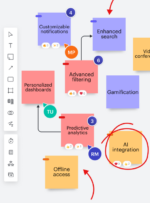
Value stream management has a messaging problem.
That was a key takeaway from the recent {virtual} VSMcon 2022, hosted by SD Times last month. What is a value stream? What is value? Which metrics matter? Is it a tooling thing? A people thing?
We empaneled some industry experts at the conference to look at the issue, and the consensus was that value stream management is indeed very useful in providing visibility into your processes, to eliminate bottlenecks and wasted time. It can save your organization time and money, keep your employees working on innovative projects rather than mundane tasks, and deliver engaging products that your customers actually want. There simply is an issue with the way people talk about value stream management – for solution providers talking to potential customers, and for the customers themselves to sell it internally.
Part of the confusion comes from the fact that delivering software is not as straightforward as manufacturing, which is where value stream management got its start. On top of that, delivering software from ideation to release is not a straight line, and there are multiple value streams serving that delivery process. Where do they intersect? Where are the dependencies? How do different teams collaborate?
One of the panelists, Scott Ambler, who’s vice president and chief scientist at the Project Management Institute, acknowledged that any definition of value is by its nature vague, because like beauty, value is in the eye of the beholder. “What is valuable to me is nothing to you, and vice versa. It’s a fuzzy world.”
Ambler would define value as delivering a quality product to customers who want it. He explained: “I see too many people declaring value. ‘Oh, look at this really valuable thing we created,’ but nobody’s interested in it. So it’s valueless. There’s zero value there. Actually negative value there, because you spent all that money and you got nothing for it.”
Then there is the question, “Are you managing value streams, or are you managing value?” This is something Lance Knight, president and COO of solution provider ConnectALL (and Charter Sponsor of VSMcon), speaks about often. “If we understand the difference between value management, and value stream management, I also think we’ll find better success. So, I want to do value stream management, what am I purchasing? What am I going to get? What is my outcome? Here’s a fun one. What’s the value I’m gonna get by implementing value stream management? What’s going to come out of that for me? And so I think that’s why people are struggling with it.”
Knight tries to keep the discussion simple. “Value stream management is pretty succinct and what that is and what it’ll do for you,” he said. VSM helps you find waste, remove it, and automate that process. But, he added, from the vendor side, “We’re all talking about other things that it can do as they try to spin it into what their solutions do. I look at the solution stack. Some of them are just giving metrics, and they’re saying that’s your value stream management solution.”
Another large impediment to value stream adoption is that it’s not a tool you can buy and just plug in and immediately gain efficiencies. It’s about the people in your organization having a willingness to examine what they do and fix things that don’t work. Jim Benson, CEO of consulting firm Modus Cooperandi, told conference attendees that this is a huge hurdle to clear. “Asking people to do something is one of the best ways to get people to fire you. For me, coming from the Lean side, VSM is the exercise of a lot of interested stakeholders getting together and figuring out what are the steps that we’re taking to create this value? How do we define the value? How do we work together? How do we collaborate with each other to do that work, and then using that as your basis for how you build out your Obeya or your visual controls. So you now have a structure for your work, you have things that are supposed to happen, you know, what you can track, how you can track it and possibly even what some of those metrics should be. We keep selling people that there’s a solution that you can buy. And what VSM is, isn’t that. It’s the box of random Legos. And you have to build your solution out of it. But yeah, you know, you actually have to show up and do the work and that sentence upsets people.”
To hear the rest of this conversation, you can listen to the panel, and all the other sessions from the conference, by registering here.






